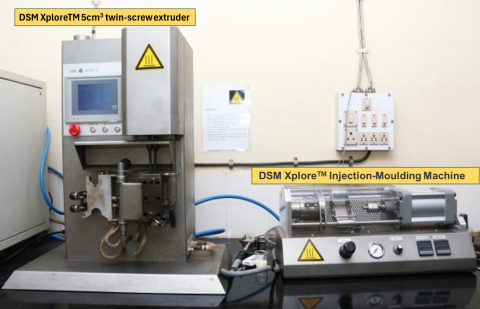
External users: registration to be carried out only through I-STEM portal
Additional information about sample and analysis details should be filled in the pdf form provided in the I-STEM portal under “DOWNLOAD CSRF”
Internal users (IITB): registration to be carried out only through DRONA portal
Additional information about sample and analysis details should be filled in the pdf form provided here.
.
Category
- Fabrication and Processing » Macrofabrication
Booking Details
Facility Management Team and Location
Facility Features, Working Principle and Specifications
Facility Description
The Polymer Processing Laboratory at IIT Bombay is equipped with advanced machinery to support research, innovation, and education in polymer science. For external users and internal users also. Key equipment includes a twin-screw extruder with four interchangeable dies (filament, sheet, fiber, and catheter) and a 3D spooler for precise winding, enabling diverse applications such as 3D printing and medical-grade tubing. A single-screw extruder provides efficient processing for simpler polymer formulations. The lab also houses a DSM Micro 5 twin-screw vertical extruder, ideal for small-scale, high-precision material development, and "Haake Mini Jet pro "a mini-injection molding machine for prototyping and testing. Additionally, a pelletizer machine ensures uniform polymer pellet production for compounding and recycling. This facility serves as a hub for cutting-edge research and technological advancements in polymer processing.
Features :
- Twin screw extruder (5cc DSM and Haake Process 11)
- Recirculation (for DSM)
- Use pellet, powder, or melt samples
- Provides efficient sample preparation for mechanical and rheological testing
- Diameter monitor for the strand
- Sheet take-off setup
- 3D Strand with MP Spooler Laser
Working principle :
The majority of polymeric raw materials are available in granules, powder, or flakes form. The transformation from solid to flowable form is carried out by heating the material. Once the material is in a melted state, mold is used to shape the material, and the resulting shape is then fixed by cooling.
Types of material we can use:
- Most thermoplastic materials, including blends, filled systems, etc.
- Size of material we can use: Typically pellets of 1-2 mm size
- Maximum temperature range of machine: 450 degree Celsius
Sample Preparation, User Instructions and Precautionary Measures
- Material should be dry, and its melting temperature should be within 300 °C
- Required sample volume depends on the instrument type that will be used.
- Carry an extra 30 - 60gm of your material.
- Material should be totally moisture and contamination free.
- Main Polymer material should be in the granules or powder form not in liquid.
- Metals, ceramics, solvents, gaseous and hazardous chemicals as an additive in the compositions are not allowed.
Instructions for users:
- Online registrations will be accepted only through the Drona for internal users and I-STEM Portal for external users. If anyone wants to cancel their slot, need to send an email immediately with an explanation.
- Slots will be provided depending on availability.
- Users must be present during the entire slot.
- Material should be oven dried before usage.
- User should be aware of the melting temperature and degradation temperature.
- Material should be free from toxin material or any harmful gases.
- Fillers that can stick to the barrel walls will not be accepted
Charges for Analytical Services in Different Categories
| User's | Respective charges |
| IIT Bombay TA's | INR 250 /Hour |
| IIT Bombay users | INR 500 /Hour |
Other Academic institutes | INR 1000 /Hour + 18% GST |
| National labs | INR 2500 /Hour + 18% GST |
| Industry and Consultancy | INR 3000 /Hour + 18% GST |
| SINE start-up | INR 1500 /Hour + 18% GST |
| Research Park (MSME) | INR 1500 /Hour + 18% GST |
| Monash IITB Students | INR 500 /Hour + 18% GST |
SAARC countries and low- income African countries | INR 2000 /Hour + 18% GST(Academia) |
| INR 3000 /Hour + 18% GST(industry) | |
| Other Countries | INR 3000 /Hour + 18% GST |
Research Park (Big Industry partners) (letter from RP reqd.) and MSME not associated with RP (appropriate certificate required) | INR 2000 /Hour + 18% GST |
Applications
- Polymer melt processing, including blends, addition of additives and fillers.
- Preparation of samples using injection molding (variety of moulds are available).
- Formulation: Analyze the influence of types of additives, fillers, concentrations, polymer types, etc.
- Processing: Measure the impact of processing time and temperature.
- Performance: Predict the performance of the material before actual application.
Sample Details
--
--
--
--
--
--
SOP, Lab Policies and Other Details
Publications
--
